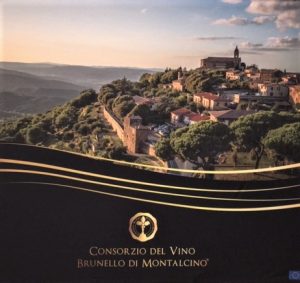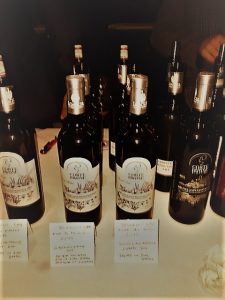 On January 27 I spent a couple hours at NYC’s Gotham Hall at Broadway and 36th for Benvenuto Brunello, a grand tasting of Brunello Di Montalcino wines. Put on by The Consortium of the Brunello of Montalcino Wine, established in 1967 on the day that the region gained DOCG (Denominazione di Origine Controllata e Garantita) status, the highest in Italy’s wine regions, guests chose from and tasted wines from among 40 providers, each of which offered between two and six wines, mostly Brunellos and Rossos, their younger siblings.
On January 27 I spent a couple hours at NYC’s Gotham Hall at Broadway and 36th for Benvenuto Brunello, a grand tasting of Brunello Di Montalcino wines. Put on by The Consortium of the Brunello of Montalcino Wine, established in 1967 on the day that the region gained DOCG (Denominazione di Origine Controllata e Garantita) status, the highest in Italy’s wine regions, guests chose from and tasted wines from among 40 providers, each of which offered between two and six wines, mostly Brunellos and Rossos, their younger siblings.
Brunellos are always 100% Sangiovese, as are Rossos, but other wines come from Montalcino (Mount Lucina), though that name translates into different things depending on whom you ask. Far as I know, the name comes from the name of the town, which is situated roughly in the region’s center, a little bit to the north and east. Montalcino’s winemaking territory itself is about 121 square miles, with 8648 acres under vine. That’s not a lot. By contrast, the Napa AVA (American Viticultural Area) has about 43,000 acres of vineyards. It’s a highly-sloped wine region, and there are many different microclimates.
Anyway, I’m not one of those folks who can taste through 40 wines and remain upright, even with pouring and spitting, so I rarely if even never try that many. My personal belief is that your palate dulls quite a bit, too, after tasting a number of wines, especially reds, even when munching break or crackers in between. Still, I tasted 13; for purposes of comparison, I tried only Brunellos, and only 2015’s. If the grapes were produced from a sub-region or if the wine has a unique name it’s indicated below, and if not, it’s simply Brunello Di Montalcino DOCG 2015. I chose them at random, so as not to favor any winery or importer.
 Please keep in mind that wine tasting and describing is subjective. As these wines are all Sangiovese, and all from the 2015 vintage, they’ll have a lot in common in terms of flavor profiles. 2015 is considered an outstanding Sangiovese harvest, with a lot of red and black cherry fruit, nice balance, some richness, and tannins that contribute nicely to the wine’s mouthfeel but aren’t astringent and mouth-puckering. I don’t give long descriptions or those “Department of Silly Walks”-like attributes (Credit: Monty Python) such as cat pee (never drank any), wet stone (never licked a rock, wet or dry), chicken stock (have tasted that in chicken stock, not wine), liquified Viagra (not going there), saddle leather (eww, and who’s been sitting on the saddle?), or wet dog (I volunteer at a shelter but never tasted one).
Please keep in mind that wine tasting and describing is subjective. As these wines are all Sangiovese, and all from the 2015 vintage, they’ll have a lot in common in terms of flavor profiles. 2015 is considered an outstanding Sangiovese harvest, with a lot of red and black cherry fruit, nice balance, some richness, and tannins that contribute nicely to the wine’s mouthfeel but aren’t astringent and mouth-puckering. I don’t give long descriptions or those “Department of Silly Walks”-like attributes (Credit: Monty Python) such as cat pee (never drank any), wet stone (never licked a rock, wet or dry), chicken stock (have tasted that in chicken stock, not wine), liquified Viagra (not going there), saddle leather (eww, and who’s been sitting on the saddle?), or wet dog (I volunteer at a shelter but never tasted one).
Here are the wines I tasted and my impressions and favorites:
+ Favorite * Numbers 2 and 3
###
Altesino, DOCG Montosoli: Solid black cherry, tannins that assaulted the roof of my mouth, and a nice long finish.
Beatesca: Not to my taste. Flat and a little bitter on the backend.
Belpoggio: Less fruit than I like but very brisk, softer tannins and a medium finish.
Carpineto: Good food wine, nicely balanced, seemed a bit light for a Brunello.
Castello Romitorio DOCG Filo Di Seta: Good aperitif wine, fresh and tangy.
+Corte Pavone DOCG Campo Marzio: My favorite. perfect tannins, great balance, great character.
Franco Pacenti DOCG Rosildo: Starts out softly and grew in intensity. Very fruity yet brisk on the backend.
Le Chiuse: Not memorable. Very little aroma, no nuance.
Mastrojanni: A solid, middle-of-the-road wine with nice fruit and a long finish.
Talenti: Fresh and fruity (apologies to Denny’s), easy-drinking food wine
Val Di Suga DOCG Val Di Suga: Blackfruit really comes at you, lovely tannins, nice 3-vineyard wine.
*Verbena DOCG Le Pope: Made from high-elevation grapes, rich, my second choice.
*Villa Poggio Salvi: Fruit-driven, brisk yet balanced, my #3.

Recent Comments